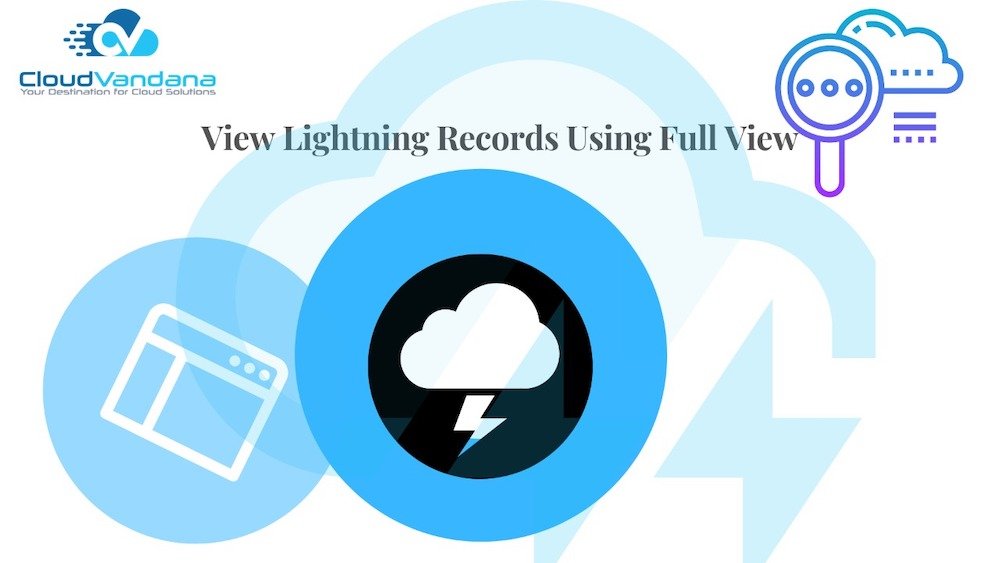View Lightning Records Using Full View

Master how to view Lightning Records using Full View in Salesforce. This guide explores setup, customization, and best practices for displaying complete record data in a scrollable, user-friendly format. Salesforce Lightning Experience is engineered to enhance user productivity through a modern, component-based interface. Among its layout options, the Full View layout offers a straightforward, scroll-based format designed for users who prefer complete visibility of a record in a single pane. As more businesses migrate to Lightning from Classic, View Lightning Records using full view acts as a bridge—offering a traditional layout with the advantages of Lightning’s dynamic components. In this comprehensive guide, we’ll explore what Full View is, how it differs from other layouts, when it’s best used, how to enable and tailor it to specific user needs, and how it supports various industry workflows. We’ll also cover best practices, performance tips, and strategies for encouraging adoption across your organization. Table of Contents View Lightning Records Using Full View What Is Full View in Salesforce Lightning? Comparing Lightning Records Full View and Grouped View in Detail Full View: A Linear Layout Grouped View: A Modular Layout Choosing Between the Two Use Cases Where Lightning Records Full View Shines Complex Case Management Regulatory and Audit Workflows Internal Operations and Admin Work Training and Learning Environments How to Enable Lightning Records Full View in Lightning App Builder Designing Effective Full View Layouts Key Design Considerations: Lightning Records Full View Across Industries Healthcare Financial Services Education Legal Firms Nonprofits Optimizing Performance in Full View Layouts Encouraging User Adoption View Lightning Records Using Full View-Final Thoughts Frequently Asked Questions (FAQs) YOU MIGHT ALSO LIKE View Lightning Records Using Full View What Is Full View in Salesforce Lightning? Full View is a record page layout option in Salesforce Lightning Experience that organizes all record-related information—including record details, related lists, and custom components—into one single scrollable column. Unlike the Grouped View, which divides the page into tabs and collapsible sections, Full View gives users a continuous, top-down snapshot of the record. This format is ideal for users who want to avoid the extra clicks and hidden data that come with tabbed navigation. It provides a holistic view of every component on the record page, minimizing interruptions and reducing cognitive load. Comparing Lightning Records Full View and Grouped View in Detail Full View: A Linear Layout Full View caters to users who prefer a consolidated approach to data consumption. When enabled, every component—Details, Related Lists, Activities, Chatter, and more—appears stacked vertically. There’s no need to click through tabs or expand sections. This is especially beneficial for users working with large datasets or reviewing records line by line. Grouped View: A Modular Layout Grouped View organizes the record page into multiple tabs (such as Details, Related, Activity), allowing users to drill into specific sections. This approach works well for sales teams and service reps who interact with only a portion of the record at any given time. It’s optimized for quick scanning and light data input but can hide useful context from users who need the full picture. Choosing Between the Two The choice between Full View and Grouped View depends on user preference, task complexity, and industry requirements. Full View offers more transparency and context, while Grouped View prioritizes speed and focused interaction. Use Cases Where Lightning Records Full View Shines Organizations often overlook how layout can impact workflow efficiency. Here are specific scenarios where Full View provides a clear advantage: Complex Case Management For service agents dealing with detailed case histories, Full View ensures that all prior communications, notes, and related activities are visible in one go. This makes it easier to provide personalized support and reduces resolution times. Regulatory and Audit Workflows In industries like finance and healthcare, where audits require complete visibility into client or patient records, Full View removes the risk of overlooking data hidden in collapsed tabs. Auditors and compliance officers benefit from seeing every interaction, field update, and related object in a single flow. Internal Operations and Admin Work Full View supports detailed workflows such as onboarding checklists, facility management, or internal ticketing. Admin users can input data, verify records, and switch between sections seamlessly without constant context switching. Training and Learning Environments New Salesforce users can feel overwhelmed by nested tabs. Full View offers a more intuitive way to explore object relationships and data structures, making it an ideal tool for onboarding and workshops. How to Enable Lightning Records Full View in Lightning App Builder Salesforce administrators can enable Full View by configuring record pages through the Lightning App Builder. Here’s a walkthrough: This layout is automatically applied when users access the record, ensuring consistency across devices. Designing Effective Full View Layouts Customization is key to getting the most out of Lightning Records Full View. The design should balance visibility with performance, helping users get information quickly without overwhelming them. Key Design Considerations: Lightning Records Full View Across Industries Salesforce is used in a wide array of industries, and each has unique needs that Full View can address effectively. Healthcare Hospitals and clinics track a wide range of patient data: visits, prescriptions, procedures, insurance, and more. Full View ensures doctors and administrative staff have access to all details in one scroll—eliminating toggling that can delay care. Financial Services Loan processors and wealth managers need a holistic view of applications, customer profiles, supporting documentation, and interaction history. Full View ensures no piece of information is missed. Education Admissions officers reviewing student applications can use Full View to evaluate transcripts, recommendations, interviews, and previous correspondence without missing key data. Legal Firms Legal records involve extensive documentation. Lightning Records Full View is ideal for displaying contracts, client interactions, timelines, and supporting materials in one location. Nonprofits Nonprofit staff managing grants, donors, or outreach campaigns benefit from having all notes, donation history, and follow-up activities displayed seamlessly. Optimizing Performance in Full View Layouts Because Full View loads all components at once, it’s important to design with performance in mind. Here’s how to keep






